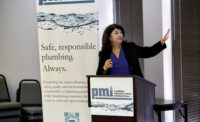During research for this column I came across a June 21 Wall Street Journal article titled “Water-Wasting Leaks Plague Many Cities.” A number in the piece leapt off the screen.
$2.6 billion.
That is the estimated value of both the National Basketball Association’s Los Angeles Lakers and the National Football League’s New England Patriots — the fifth- and sixth-most valuable sports franchises respectively, according to a Forbes 2015 ranking.
According to an Environmental Protection Agency report, $2.6 billion also is the estimated amount United States utilities lose annually from leaked water. In theory, if we as a nation put in the funds to repair our crumbling water infrastructure we could subsidize a top-flight football team.
A scenario such as that is insane. We need to take action so as a nation we can put that money into other necessary programs or even back into the pockets of the American taxpayers.
The Wall Street Journal article hammers home some other incredible points about our nation’s failing water infrastructure.
• According to the American Society of Civil Engineers, about 240,000 water-main breaks are expected to happen in the country annually.
• According to a 2013 EPA report, the nation’s more than 52,000 water utilities need $384 billion to repair and improve pipes and filtration systems.
• According to a 2015 Congressional Budget Office report, public spending on transportation and water infrastructure nationally as a share of the gross domestic product fell from 3% in 1959 to 2.4% in 2014.
I did some light Internet research and found that the U.S. GDP in 1959 was $3.06 trillion and the country invested $91.8 billion into water infrastructure. In 2014, those numbers changed to $16.15 trillion and $387.6 billion. But, if the country had stayed at the same level of spending, the investment would have risen to $484.5 billion. How many sports teams could we subsidize with that difference? Better yet, how much maintenance and other problems could we have avoided?
Now let’s take a look at California, our cradle of innovation from tech to water-saving measures. Back in April, Dianne Feinstein, longtime Democratic senator from the Golden State, told the Sacramento Bee the state has “the same water infrastructure from when we were 16 million people.” In 2014, California’s population was 38.8 million.
Politifact.com, a project run by the Tampa Bay Times, looked into her statement and rated it “mostly true.” Feinstein's quote was rated mostly true because there were some completed water infrastructure projects in relation to the state’s farms and cities in the 1970s and other regional enhancements were made, but no statewide projects were undertaken.
Utilizing essentially the same system despite an additional 22.8 million users and who knows how many more businesses, golf courses, water parks and more since the 1960s is foolhardy.
And the cherry on top of everything I laid out above is we could save lives with comprehensive reforms of our nation’s infrastructure. Legionella, other water-borne pathogens and lead poisoning would be greatly reduced (or eliminated) with an overhaul.
Enough is enough and it is time to upgrade.
This article was originally titled “A penny spent can be a penny earned” in the July 2016 print edition of PM Engineer (pme).




